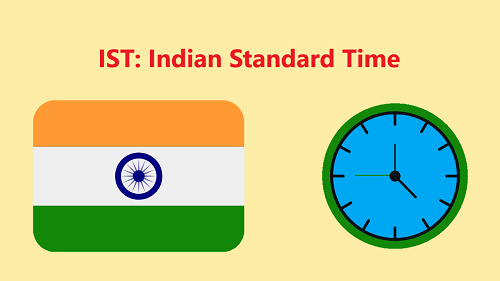What is the full form of ISTIST: Indian Standard Time
IST stands for the Indian Standard Time. It is the zone of time which is used or observed all over India. It is 5 hours and 30 minutes ahead of the Green Meridian Time. Daylight saving time or other seasonal adjustments are not seen in India. The Indian Standard Time is at present maintained and looked after by the Council of Scientific and Industrial Research - National Physical Laboratory (CSIR-NPL) with assistance from the Allahabad Observatory. Origin of the Standard TimeAs a concept, it was introduced when the local times started becoming obstruction, in the way of administration, specifically railway, in the nineteenth century. The presence of numerous local times didn't let the decision makers create a uniform timetable, due to the variation in time zones. This issue was more prominent in bigger regions and countries such as Canada and the United State of America. Here, the local train route used to cross long distances and very often passed through locations that differed by many hours, as under the concept of local time. It was in the 1870s, that Sir Sandford Fleming, introduced the world to the idea of worldwide standard time. HistoryIt was after the independence of India in 1947 that the Central Government set up IST as the time zone officially for complete India. Up until 1948 and 1955, Kolkata and Bombay had their own local time zones, respectively known as the Calcutta time and Bombay Time. Furthermore, the central observatory was then shifted from Chennai to some location in Uttar Pradesh, so that it would be close to the + 5:30. During the India China war of 1962 and the India Pakistan war of 1965 and 1971, the Daylight Saving Time (DST) was in brief used. During the colonial period, the meridian passing east of Allahabad was used as the British Indian standard time zone. Which was further on declared to be the Indian Standard Time zone in 1947. How is Calculation Done?82.5° E longitude is the reference longitude for the Indian Standard Time. The clock tower in Mirzapur is where nearly the exact reference longitude is located. Nowadays, many countries choose to have multiple standard time zones, as the concept of standard time has been primarily introduced for administrative purposes. Such as the countries like the USA, Russia, France, Canada and the like have more than one standard time. Need for standard time zoneThe standard time is set according to the law and administration of a country or a region specifically. It is to satisfy and synchronize the various different time zones of that country or region to a standard time. 82°5 E Longitude passing through Naini near Allahabad was chosen as the standard meridian for the whole dominion of India because there is more than a one-hour time lag in western India and eastern India. The easternmost point is about (+5:00 GMT) and the westernmost point is about (+6:00 GMT). So as to standardize the time of the whole country the mid-point is taken from the longitude passing through central India. Advantages of Standard TimeThe adoption of the concept of a universal standard time was not done without any purpose. The following are some of the significant advantages of standard time.
Disadvantages of Standard TimeAlthough the concept of standard time is the predominant time concept followed by the world today, it is not without its share of limitations.
Next TopicFull Form
|
 For Videos Join Our Youtube Channel: Join Now
For Videos Join Our Youtube Channel: Join Now
Feedback
- Send your Feedback to [email protected]
Help Others, Please Share










